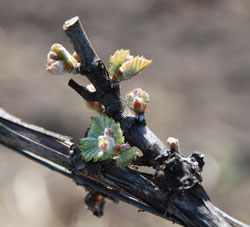The summer and fall are when most of the action happens in the vineyard as leaves are thinned and grapes ripen on their journey to be turned into wine. But none of that matters if the vines aren’t healthy going into the summer. As “Backyard Vines” columnist Wes Hagen puts it, “Spring is where the vintage is made.” From pruning, knocking the suckers (basal shoots) off the base and trunk of the vines, and replacing vines or trellises, to spraying and protecting the vines from the weather or other risks, spring is not a time home viticulturists can take off. For help understanding the spring workload, we sought the advice of a pro winemaker in the Texas Hill Country and another in the Santa Cruz Mountains of California for their list of spring chores.
Eric Weisinger, Winemaker at Signor Vineyards in Fredericksburg, Texas

In our region, here in the Texas Hill Country, frost is the biggest threat that spring brings — which is probably the biggest risk for all vineyards unless you’re lucky enough to be in a location that doesn’t have the threat of an occasional below-freezing night. Bud break in our vineyard happens at the end of March so frost that comes after that point can do real damage if we aren’t prepared. We mitigate the risk of frost damage through a sprinkler system that we have set up throughout the vineyard. This has been successful for us but if you’re a home winemaker with a half-acre vineyard and aren’t able to install some sort of sprinkler system there is not much that can be done to help alleviate the risk of frost damage.
Our spring spray program here at Signor is conventional. It’s a variety of fungicide sprays, but a majority of the sprays are sulfur. We spray once every two weeks. At this point, spraying is our only real protection against pests and, luckily, pests at this point have not been much of an issue in our vineyards. We have been quite fortunate. Depending on the conditions, we may apply an herbicide to fight weeds.
Regarding pruning strategy: We do a mix of cordon pruning and cane pruning. With each of them leaving eight to ten buds per cane or cordon. Then we shoot thin when the shoots are 4 to 6 inches (10 to 15 cm) long.
Someone once told me this in French and the translation goes something like this: “There are no substitutes for footprints in the vineyard.” What that means is that you just have to get out there and walk. You can have an issue out in the vineyard, but if you don’t get out there to see it then you won’t know. And if you are able to find any vineyard issues early enough, you can usually find a remedy before it negatively impacts the vines and the grapes that will be produced in the summer and fall.
John Bargetto, Winemaker at Bargetto Winery in Santa Cruz, California

Our vineyards are on a hill close to Monterey Bay, so even though it is a cooler climate vineyard we don’t have to face frost concerns in the spring. Bud break for the seven varietals we grow range from March 1 to April 1. The biggest danger for us in the spring is the weeds. We abandoned Roundup spray two years ago and began taking on weeds with organic measures. We are uncertain as to their efficacy just yet. We hope that 2020 will be the first year we use sheep to help with weed control. Other issues that come with the spring are rains delaying sprays at times, and Eutypa (a genus of fungi) is in the air so we pay attention to pruning wounds. Gophers can also be a problem. We keep them at bay by hunting them like crazy.
We cane prune all of our vineyards with shoot removal at 12 to 18 inches. Other spring vineyard chores include walking the vineyard looking for damage to vines, trellising, posts, and our irrigation system. Any vines that have died off will be replaced with a new vine from our nursery and we will repair or replace posts each spring. Outside of the vineyard we’ll also spend time checking the shape of other equipment from tractors to tools, making sure they are in good order when the time comes to put them to use. Doing these checks before it is time to use them will save home winemakers frustration and anxiety compared to holding off on doing so until the equipment is needed.
My best advice for spring maintenance for any hobbyist who has a vineyard, having had pruned aggressively in the wintertime, is to paint wounds, control weeds, and kill gophers (or protect your vines from whatever pests may be a risk where you live in a way you see fit). Most backyard grape growers likely aren’t selling their grapes, but if any of you are growing excess grapes to sell, try getting them contracted as early as you can — you don’t want to wait until September!







